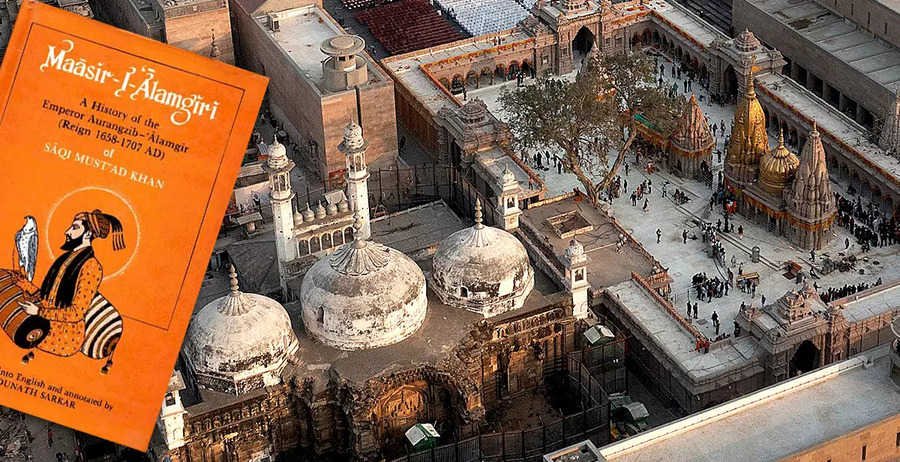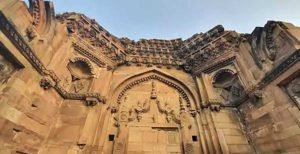Proof of Aurangzeb razed Kashi Vishwanath temple and The secret of Gyanvapi is hidden in Aurangzeb’s record – ‘Maasir-e-Alamgiri’


Record when Kashi Vishwanath temple demolished: The controversy over the Gyanvapi mosque complex in Varanasi has again brought all the focus back to the Mughal ruler Aurangzeb. People believe that Aurangzeb destroyed the temple of Lord Shiva and built a mosque at the same place. The wall of Gyanvapi is shown as an archaeological evidence, which looks like a temple when seen. Apart from this the idol of Nandi, whose face is towards the mosque. But barring these two, is there any contemporary evidence to prove that Aurangzeb ordered the demolition of the temple?
When we talk of contemporary evidence, especially literary evidence, the matter becomes a bit delicate. In the Ayodhya case, a huge assumption was made on the ground that there was no written evidence of the demolition of the Ram temple at that time. The pages of Babar, who is accused of building a mosque by demolishing the Ram temple, are missing from his diary after April 2, 1528. He entered Ayodhya on the same day. After this date his diary finds mention from September 1528. By then he had left Ayodhya.
While the hearing of the Ram Janmabhoomi case was going on, the Hindu faction may have presented archaeological, inscriptions and written evidence of travelers visiting India in the 17th century. Especially the record made by the Austrian priest Joseph Teufenthaler may have been put forward, but the fact is that there is no literary evidence of the temple demolition at the time of Babur.
Now let’s come to Banaras. There is written evidence in the form of official records of Aurangzeb himself. The Mughal ruler had a very trusted secretary, Inayatullah Khan Kashmiri. He appointed Saki Mustaid Khan to record the reign of Aurangzeb. Mustaid has written all the proceedings and correspondence of the royal court in a systematic manner. On the basis of these, Aurangzeb’s orders, system of governance, his policies and decisions can be understood.
Mustaid has written everything in Persian and knows it as Maasir-e-Alamgiri. It has an account of nearly five decades, from 1668-69 to the death of Aurangzeb in 1707. Aurangzeb captured the throne in 1658-59 by imprisoning father Shah Jahan and killing his brother Darashikoh. Another historian, Mirza Mohammad Kazim, wrote about the first decade of his reign. But, there is a mention about Kashi in Mustaid’s record.
Historian Jadunath Sarkar has translated Maasir-i-Alamgiri. According to this, as early as 1669, Aurangzeb found that the Brahmins of Banaras were teaching with wrong books and wrong things were being taught to the students. By wrong things Aurangzeb meant Hindu religious texts. Mustaid’s record says that Aurangzeb wanted to stop all these teachings. He wanted the temples of Banaras as well as Multan to be demolished, worshiping at these places should be banned.

What is written about Aurangzeb’s order in Maasir-i-Alamgiri is something like, ‘The emperor has come to know that Brahmins in Tatta, Multan and especially in Banaras are reading wrong books in their schools. People come from far and wide to take education from him. Among them there are Hindus as well as Muslims. The emperor wants to establish the rule of Islam, so he orders the governors of all the provinces that the schools and temples of the infidels should be demolished.
A few months after this order, it was written on 2 September 1669 on behalf of Mustaid Khan, ‘There has been news in the court that as per the orders of the emperor, the temple of Vishwanath in Banaras was demolished.’
The Maasir-i-Alamgiri gives information not only about Kashi, but also about what happened to the temples in the areas of Mughal rule after 1669. According to Mustaid’s writings, the temple in Mathura was demolished in the early 1670s. After this, on the orders of Aurangzeb, temples were destroyed in Rajasthan, Maharashtra and other parts of the Mughal Sultanate.
The special thing is that Mustaid Khan was not a historian of any opposing camp. He was appointed by a trusted courtier of Aurangzeb. He saw with his own eyes all the orders of the emperor and also the reports which were sent to the court by the chiefs of the province.
DISCLAIMER: The author is solely responsible for the views expressed in this article. The author carries the responsibility for citing and/or licensing of images utilized within the text.
